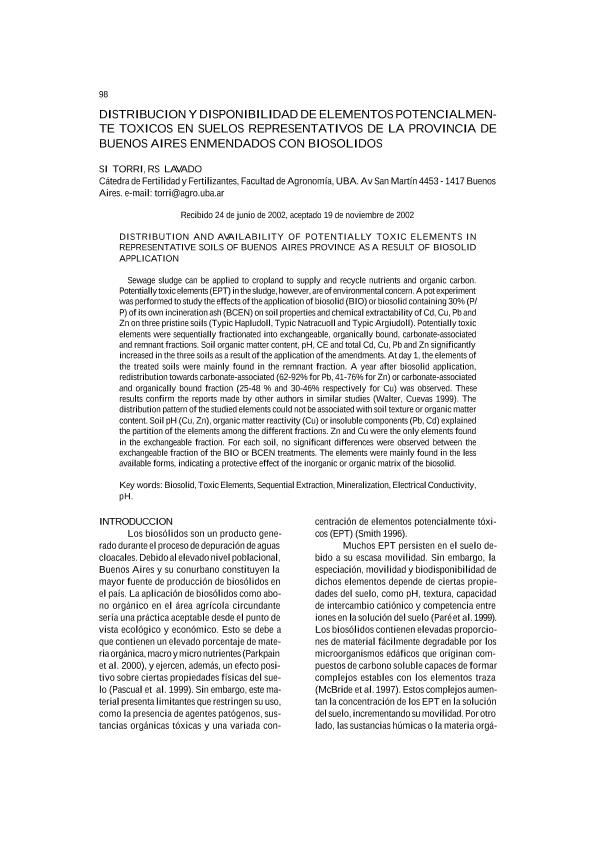Artículo
Distribución y disponibilidad de elementos potencialmente tóxicos en suelos representativos de la Provincia de Buenos Aires enmendados con biosólidos
Título:
Distribution and availability of potentially toxic elements in representative soils of Buenos Aires Province as a result of biosolid application
Fecha de publicación:
12/2002
Editorial:
Asociación Argentina de la Ciencia del Suelo
Revista:
Ciencia del Suelo
ISSN:
0326-3169
Idioma:
Español
Tipo de recurso:
Artículo publicado
Clasificación temática:
Resumen
Sewage sludge can be applied to cropland to supply and recycle nutrients and organic carbon. Potentially toxic elements (EPT) in the sludge, however, are of environmental concern. A pot experiment was performed to study the effects of the application of biosolid (BIO) or biosolid containing 30% (P/ P) of its own incineration ash (BCEN) on soil properties and chemical extractability of Cd, Cu, Pb and Zn on three pristine soils (Typic Hapludoll, Typic Natracuoll and Typic Argiudoll). Potentially toxic elements were sequentially fractionated into exchangeable, organically bound, carbonate-associated and remnant fractions. Soil organic matter content, pH, CE and total Cd, Cu, Pb and Zn significantly increased in the three soils as a result of the application of the amendments. At day 1, the elements of the treated soils were mainly found in the remnant fraction. A year after biosolid application, redistribution towards carbonate-associated (62-92% for Pb, 41-76% for Zn) or carbonate-associated and organically bound fraction (25-48 % and 30-46% respectively for Cu) was observed. These results confirm the reports made by other authors in similar studies (Walter, Cuevas 1999). The distribution pattern of the studied elements could not be associated with soil texture or organic matter content. Soil pH (Cu, Zn), organic matter reactivity (Cu) or insoluble components (Pb, Cd) explained the partition of the elements among the different fractions. Zn and Cu were the only elements found in the exchangeable fraction. For each soil, no significant differences were observed between the exchangeable fraction of the BIO or BCEN treatments. The elements were mainly found in the less available forms, indicating a protective effect of the inorganic or organic matrix of the biosolid.
Archivos asociados
Licencia
Identificadores
Colecciones
Articulos(INBA)
Articulos de INST.DE INVEST. EN BIOCIENCIAS AGRICOLAS Y AMBIENTALES
Articulos de INST.DE INVEST. EN BIOCIENCIAS AGRICOLAS Y AMBIENTALES
Citación
Torri, Silvana Irene; Lavado, Raul Silvio; Distribución y disponibilidad de elementos potencialmente tóxicos en suelos representativos de la Provincia de Buenos Aires enmendados con biosólidos; Asociación Argentina de la Ciencia del Suelo; Ciencia del Suelo; 20; 2; 12-2002; 98-109
Compartir




